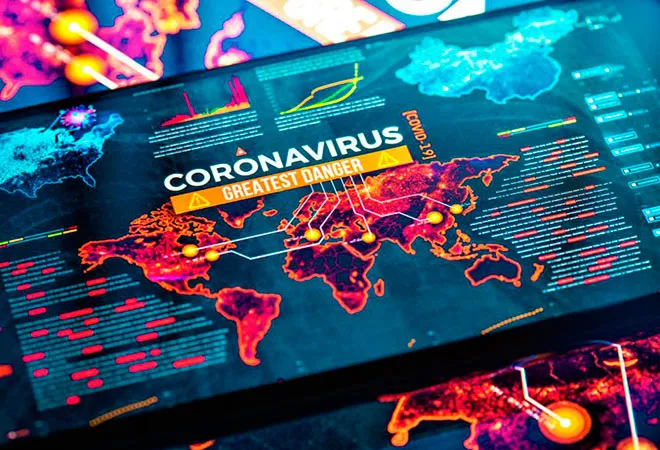
The ongoing COVID-19 pandemic has created havoc across the world, putting extraordinary pressure on not just public health systems, but also on crisis communications. With social media being the primary medium for information consumption, clear, end-to-end crisis communication with diverse target groups becomes key in dealing with such a pandemic.
On 11 March 2020, the World Health Organisation's (WHO) declared COVID-19 a pandemic as the number of cases worldwide had surged 13-fold. At that time, only 62 cases were reported in India, a mere 0.05 percent of the global count. While many European countries and the WHO had understood the severity of the crisis and the need to combat the situation, India was still sitting on the fence trying to play defensively, biding time before facing the avalanche. Was India late to act?
Centre, States and Pandemic
With about 736 districts in 28 states and eight union territories, and varied shades of dialects and cultures within the states, crisis communication in India becomes a complex exercise. It not only has to address 1.3 billion citizens, but it also has to chalk out customised, tailor-made crisis communication plans for every state and sections of the society, especially the poor and marginalised. In the initial days of the outbreak in India, the early affected states prepared their own state-specific response, while New Delhi was still unsure of a nationwide strategy. Clearly, coordination between the states and the centre could have been better. While the state government had started imposing statewide curfews by invoking section 144 of the Criminal Procedure Code (CrPC), a clear direction from the centre only came on 19 March when Prime Minister Narendra Modi called for a 'Janta Curfew' to be observed on 22 March. But in several places across the country, the curfew ended up with large groups of people congregating to clap/ring bells for five minutes to acknowledge the efforts of health care staff, police, media persons and those involved in the provision of essential services, showing early signs of the scant regard for the social distancing norm. Such was the response to the ‘Clap Act,’ that the main messaging of forming an ‘Covid-19 Economic Response Task Force’ under the leadership of Union Finance Minister Nirmala Sitharaman got blurred. Two days later, the Prime Minister announced the complete countrywide lockdown for 21 days, resulting in panic buying situation in several parts of the country. Both the messages were high on ‘symbolism’, but lacked clarity and detailing. On the contrary, various states, especially Kerala and Maharashtra, implemented a comprehensive and holistic crisis communication strategy by constantly engaging with its citizens by clearly dishing out official statistics. They also announced precautionary measures to be observed and conveyed the respective governments’ action plans through various media channels. These interactions, though repetitive at times, ensured maximum outreach and, as far as possible, minimised the scope for any undue panic among the public. Now that the crisis has spiraled from the ‘prodromal’ stage to ‘in-crisis’ stage, the central leadership should adopt the ‘Rhetorical Arena Theory,’ also called as the ‘multi-vocal approach.’ The theory basically informs tactical facilitation of a collaborative approach among multitude of actors – government officials from the centre and the states, quasi government agencies, disaster management teams, media representatives and NGOs – to act collectively through constant consultations, data sharing and discussions during crisis. Such collaborative partnerships in communication ensures grassroot-level penetration of key messaging and streamlining the flow of communication at macro and micro levels, while restricting the scope of fake news/rumor mongering.
Inclusive communication: Need of the hour
The efficacy of any crisis communication strategy, especially during public health disasters, depend equally on the accuracy of information disseminated and also its inclusivity. As the term 'communication' is expressive in itself, the interpretation and receptivity towards the messaging varies for different groups. While the jury is still out on whether COVID 19 has entered the third stage in India, the agencies involved in communicating with different stakeholders should device an inclusive communication strategy to address concerns of people belonging to diverse social and economic groups. As the public communication pedals through different mediums, it should ensure that it doesn't discriminate or stigmatise the content consumer. Moreover, the communication/announcement from the government or its representative shouldn't influence the behaviour of the citizens. For example, the inability of the Delhi government to stop the mass exodus of migrant workers to UP exposed the glaring failure of its communications strategy. On the other hand, timely inclusive personal communication from Chief Minister Uddhav Thackeray assuring the migrant community in Maharashtra of their safety and wellbeing by announcing safety camps, set an example for other states to follow. Such inclusivity in crisis communication is in accordance with the WHO's International Health Regulations (IHR), which oblige the state to ‘respect human rights.’
COVID 19 experience calls for legislative changes
The emergence of COVID 19 in India has raised the alarm and exposed the loopholes not only in the public healthcare sphere, but also in the allied legal frame work pertaining to risk communication and crisis management. The government has enforced the lockdown under the provision of the colonial Epidemic Disease Act, 1897 and the more recent National Disaster Management Act, 2005. However, both these acts do not elaborate explicitly on crisis communications, one of the most important tools of crisis management in such times. But these legislations need to be urgently amended and expanded to chart out a national crisis management framework, keeping in mind the exponential growth of digital communication channels. Additionally, the WHO should alter the IHR and properly establish global protocols for mitigating crisis/risk communications. The policymakers should take leads from the Hyogo Framework, which sets out a workplan of crisis management and details out the communication framework during crisis. It sates, “Develop early warning systems that are people centered, in particular systems whose warnings are timely and understandable to those at risk, which take into account the demographic, gender, cultural and livelihood characteristics of the target audiences, including guidance on how to act upon warnings.” Similar broad and all-encompassing guidelines needs to be embedded in the legal framework in order to make it more contemporary.
While amending laws will take time, the Government of India and all its ministry concerned must proactively engage with their counterparts in the states as well as civil society organisations to strengthen their communication channels and messaging, before the country gets swamped by the impact of COVID-19’s increased community spread.
The views expressed above belong to the author(s). ORF research and analyses now available on Telegram! Click here to access our curated content — blogs, longforms and interviews.




 PREV
PREV


